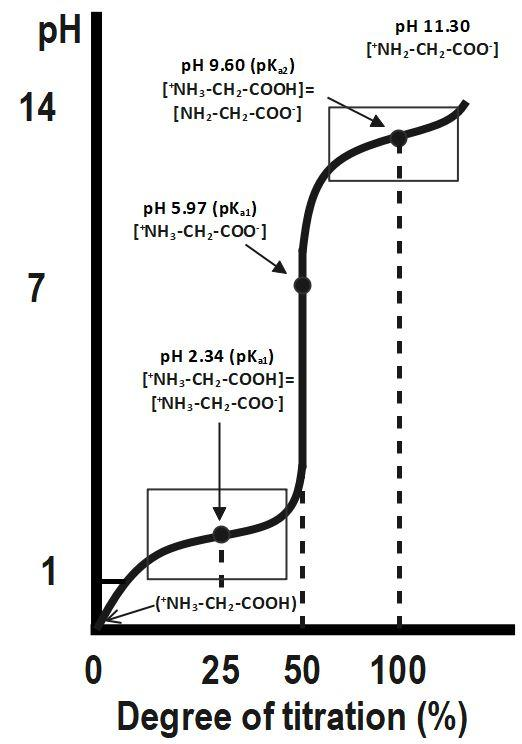
What is the titration curve of glycine?
Answer
428.7k+ views
1 likes
Hint :We know that equivalence point is a point in titration at which the amount of titrant added can completely neutralize the analytic solution. At this equivalence point in an acid-base titration, the number of moles of base becomes equal to the number of moles of acid and then the solution is only left with salt and water.
Complete Step By Step Answer:
The process of titration is a chemical analysis which is used to find out the concentration of unknown solution by adding a solution of known concentration. The known solution is known as titrant and the unknown solution is known as analytic. Equivalent point is the point where the concentration of the acid and base is equivalent. Strong acids and bases neutralize each other completely at equivalence points.
Below is a typical curve for the titration of glycine with

Although we often write glycine as
The loss of H+ from the carboxyl group;
The loss of
The first equivalence point, at
Halfway between
At
Each amino acid has a characteristic set of
Note :
Remember that pH value in chemistry is a method of measurement of the acidic or the basic nature of a solution or substance. A substance or solution is acidic if it has high concentration of hydrogen ions and is basic if it has high concentration of hydroxide ions or the low concentration of hydrogen ions. pH has an important role in reflecting the chemical properties of the solutions. pH have various activities such as control of the microbial or the biological functions, properties of certain chemicals and their behaviour.
Complete Step By Step Answer:
The process of titration is a chemical analysis which is used to find out the concentration of unknown solution by adding a solution of known concentration. The known solution is known as titrant and the unknown solution is known as analytic. Equivalent point is the point where the concentration of the acid and base is equivalent. Strong acids and bases neutralize each other completely at equivalence points.
Below is a typical curve for the titration of glycine with

Although we often write glycine as
The loss of H+ from the carboxyl group;
The loss of
The first equivalence point, at
Halfway between
At
Each amino acid has a characteristic set of
Note :
Remember that pH value in chemistry is a method of measurement of the acidic or the basic nature of a solution or substance. A substance or solution is acidic if it has high concentration of hydrogen ions and is basic if it has high concentration of hydroxide ions or the low concentration of hydrogen ions. pH has an important role in reflecting the chemical properties of the solutions. pH have various activities such as control of the microbial or the biological functions, properties of certain chemicals and their behaviour.
Latest Vedantu courses for you
Grade 11 Science PCM | CBSE | SCHOOL | English
CBSE (2025-26)
School Full course for CBSE students
₹41,848 per year
Recently Updated Pages
Master Class 9 General Knowledge: Engaging Questions & Answers for Success

Master Class 9 English: Engaging Questions & Answers for Success

Master Class 9 Science: Engaging Questions & Answers for Success

Master Class 9 Social Science: Engaging Questions & Answers for Success

Master Class 9 Maths: Engaging Questions & Answers for Success

Class 9 Question and Answer - Your Ultimate Solutions Guide

Trending doubts
Give 10 examples of unisexual and bisexual flowers

Draw a labelled sketch of the human eye class 12 physics CBSE

Differentiate between homogeneous and heterogeneous class 12 chemistry CBSE

Differentiate between insitu conservation and exsitu class 12 biology CBSE

What are the major means of transport Explain each class 12 social science CBSE

Draw a diagram of a flower and name the parts class 12 biology ICSE




